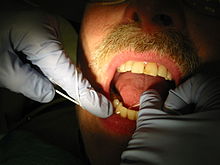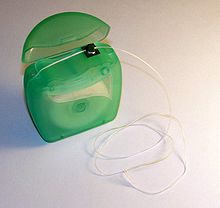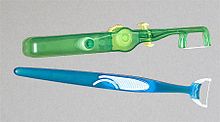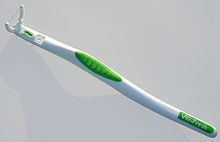- Dental floss
-
Dental floss is made of either a bundle of thin nylon filaments or a plastic (Teflon or polyethylene) ribbon used to remove food and dental plaque from teeth. The floss is gently inserted between the teeth and scraped along the teeth sides, especially close to the gums. Dental floss may be flavored or unflavored, and waxed or unwaxed. An alternative tool to achieve the same effect is the interdental brush.
Contents
History
Levi Spear Parmly, a dentist from New Orleans, is credited with inventing the first form of dental floss. He recommended that people should clean their teeth with silk floss in 1815.[1]
Dental floss was still unavailable to the consumer until the Codman and Shurtleft company started producing human-usable unwaxed silk floss in 1882. In 1898, the Johnson & Johnson Corporation received the first patent for dental floss. Other early brands included Red Cross, Salter Sill Co. and Brunswick.
A character is depicted using dental floss in James Joyce's famous novel Ulysses (serialised 1918-1920) and is an early mention of the practice in literary fiction.
The adoption of floss was poor before World War II. It was around this time, however, that Dr. Charles C. Bass developed nylon floss. Nylon floss was found to be better than silk because of its greater abrasion resistance and elasticity. In response to environmental concerns, dental floss made from biodegradable materials is now available.
Dentists and dental hygienists urge the daily oral hygiene regimen of toothbrushing and flossing. Nearly all Americans brush their teeth. However, studies have found that only 10% to 40% of Americans report flossing on a daily basis.[2]
Use
Dental floss is commonly supplied in plastic dispensers that contain 10 to 50 meters of floss. After pulling out the desired amount, the floss is pulled against a small protected blade in the dispenser to sever it.
Dental floss is held between the fingers. The floss is guided between each tooth and under the gumline to remove particles of food stuck between teeth and dento-bacterial plaque that adhere to such dental surfaces. Ideally using a C-shape, the floss is curved around a tooth and placed under the gumline, and then moved away from the gumline, the floss scrapes the side of each tooth, and can also clean the front or back of the tooth. Gently moving the floss from below the gumline to away from the gumline removes dento-bacterial plaque attached to teeth surfaces above and below the gumline. A clean section of floss can be used to clean each tooth to avoid transmitting plaque bacteria from one tooth to another.
There are many different kinds of dental floss commonly available. The most important variable is thickness. If the floss is too thick for the space between a pair of teeth then it will be difficult or impossible to get the floss down between the teeth. On the other hand, if the floss is too thin, it may be too weak and break. Different floss will suit different mouths, and even different parts of one mouth. This is because some teeth have a smaller gap between them than others. It's possible that thicker floss does a better job of scraping bacterial plaque off teeth, given that there is space enough between the teeth to use it. When a piece of hard food is tightly wedged between the teeth, one may need to switch to thinner floss, because thick floss cannot get past the food. It is possible to split some kinds of dental floss lengthwise generating a pair of thinner pieces that are much weaker but sometimes usable. This is possible because some kinds of dental floss are made of many very thin strands that are not woven together but rather run more or less in parallel. This can also be useful if the dental floss you have is too thick for you, for any other reason, and you do not have access to any other, for example when travelling in a foreign country.
Specialized plastic wands, or floss picks, have been produced to hold the floss. These may be attached to or separate from a floss dispenser. While wands do not pinch fingers like regular floss can, using a wand may be awkward and can also make it difficult to floss at all the angles possible with regular floss. These types of flossers also run the risk of missing the area under the gum line that needs to be flossed. On the other hand, the enhanced reach of a wand can make flossing the back teeth easier.
Ergonomic flossers with improved handle for better grip and swiveling floss heads allow easy access to any pair of teeth in the mouth, to the front teeth as well as to the rear teeth. Their floss heads also feature a lateral flexibility that enables improved control for the dental floss to hug the sides of the teeth and clean under the gum line without the danger of hurting the gums.
Occasional flossing and/or improper flossing can typically lead to bleeding gums. The main cause of the bleeding is inflammation of the gingival tissue due to gingivitis.
Directions
The American Dental Association advises to floss thoroughly once or more per day. While they do not make a recommendation regarding the order of brushing and flossing, flossing prior to brushing allows for fluoride from the toothpaste to reach between the teeth.[3] Overly vigorous or incorrect flossing can result in gum tissue damage. For proper flossing, the Association advises to curve the floss against the side of the tooth in a 'C' shape (making sure the floss does not snap into the gap[4]), and then to wipe the tooth from under the gumline (very gently) to the tip two or three times, repeated on adjacent and subsequent teeth.
Vibration
Some power flossers use vibration which transfers through the floss, originating from the ends. This is likely inspired by the similar use of vibration of the bristles in modern electric toothbrushes. As the vibration causes subtle movement, the floss will find the path of least resistance when pressed down. The movement would also help in temporarily separating tooth and gum for floss to get through.
This allows easier penetration under the gumline, with less force applied to push into the gap between teeth. With less force applied, more control of flossing is possible. In normal flossing, pressure may be applied until the floss 'pops' through the teeth, and the momentum can carry on and painfully impact the gum tissue. With more control, this can be reduced or avoided completely.
Many consider vibrations to be soothing; it is a common technique in massage and orthopedic devices. Much like electric toothbrushes are soothing to the teeth and gums, vibrating floss can soothe and massage the gumline.
Cuts become less likely as the floss will not press against as isolated an area, and less pressure is applied. Any abrasions to the gum would be more evenly distributed, leading to more equal adaptation of the tissue.[citation needed]
Benefits
Flossing in combination with toothbrushing can prevent gum disease,[5] halitosis,[6] and dental caries.[7][8] Regular flossing is also linked to reduced incidence of heart disease.[9] Flossing is correlated with greater longevity, potentially as a result of the prevention of gum inflammation.[10][11]
Floss threader
A floss threader is loop of fiber (similar to fishing line) used to thread floss into small places around teeth. Threaders are sometimes required to floss with dental braces, fix retainers, bridges, and crowns.
See also
- Floss pick
- Interdental brush
- Tongue cleaner
- Crest Glide
References
- ^ Sanoudos M, Christen AG. (1999). Levi Spear Parmly: The Apostle of Dental Hygiene. Journal of the History of Dentistry. 47(1): 3-6.
- ^ K. Bauroth, et. al. Journal of the American Dental Association, Vol 134, No 3, 359-365. "The efficacy of an essential oil antiseptic mouthrinse vs. dental floss in controlling interproximal gingivitis ". Accessed 15 November 2009.
- ^ American Dental Association, "Floss and Other Interdental Cleaners". Accessed 12 April 2010.
- ^ http://www.adha.org/oralhealth/flossing.htm
- ^ American Dental Association, "What does floss do?". Accessed 28 November 2009.
- ^ American Dental Association, "Bad Breath (Halitosis)". Accessed 28 November 2009.
- ^ American Dental Association, "Cleaning your teeth and gums".
- ^ American Dental Association, "Cavity Prevention Tips". Accessed 28 November 2009.
- ^ "Dental floss may lower heart disease risk". December 17, 2009. http://www.upi.com/Health_News/2008/12/17/Dental-floss-may-lower-heart-disease-risk/UPI-81571229574870/. Retrieved October 18, 2009.
- ^ [1]
- ^ [2]
External links
Periodontology Tissues of the periodontium
and their physiologic entitiesAlveolar bone · Biologic width · Bundle bone · Cementum · Free gingival margin · Gingiva · Gingival fibers · Gingival sulcus · Junctional epithelium · Mucogingival junction · Periodontal ligament · Sulcular epithelium · StipplingDiagnoses Chronic periodontitis · Localized aggressive periodontitis · Generalized aggressive periodontitis · Periodontitis as a manifestation of systemic disease · Necrotizing periodontal diseases · Abscesses of the periodontium · Combined periodontic-endodontic lesionsPathogenesis A. actinomycetemcomitans · Capnocytophaga sp. · F. nucleatum · P. gingivalis · P. intermedia · T. forsythia · T. denticolaPathologic entities Calculus · Clinical attachment loss · Edentulism · Fremitus · Furcation defect · Gingival enlargement · Gingival pocket · Gingivitis · Horizontal bony defect · Linear gingival erythema · Occlusal trauma · Periodontal pocket · Periodontal disease · Periodontitis · Plaque · Recession · Vertical bony defectDiagnosis, treatment planning,
prevention and
chemotherapeutic agentsBrushing · Bleeding on probing · Chlorhexidine gluconate · Enamel matrix derivative · Flossing · Hydrogen peroxide · Mouthwash · Oral hygiene · Tetracycline · TriclosanPeriodontal armamentarium Conventional therapy Surgical therapy and
periodontal surgeryApically positioned flap · Bone graft · Coronally positioned flap · Crown lengthening · Open flap debridement · Free gingival graft · Gingivectomy · Guided bone regeneration · Guided tissue regeneration · Implant Placement · Lateral pedicle graft · Pocket reduction surgery · Sinus lift · Subepithelial connective tissue graftImportant personalities Per-Ingvar Brånemark · Jan Lindhe · Preston D. Miller · Willoughby D. Miller · Carl E. Misch · John Mankey Riggs · Jørgen Slots · Dennis P. Tarnow · Hom-Lay Wang · James Leon Williams · W. J. YoungerOther specialties Endodontology · Orthodontology · ProsthodontologyCategories:- Dental equipment
- Oral hygiene
- American inventions
Wikimedia Foundation. 2010.




